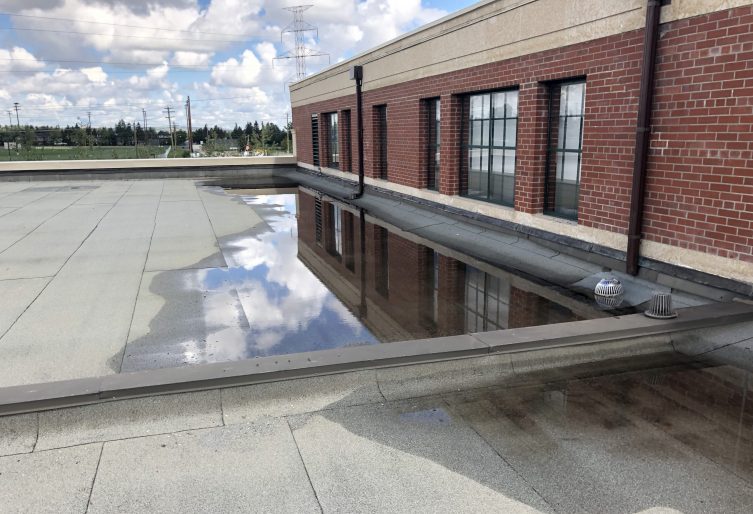When you think about maintenance of retail, commercial, and residential buildings, the last thing many people think of is roof care. While roofs are a major component of the building envelope, if they perform properly, we rarely think about them. However, problems can grow unchecked until it’s too late and you’re left catching water dripping from the ceiling.
With roof materials and replacement costs rising, the importance of roof care and prolonging its service life cannot be understated.
Roof systems are constantly exposed to many types of hazards. These range from unrelenting UV rays, extreme temperature fluctuations, snow and hailstorms, trees blowing over their leaves and twigs, or even a well-intentioned contractor engaged to install your new satellite system. These constant exposures may not amount to much this year or next, but when you consider roof systems are anticipated to last 25+ years, they can become a larger concern. Long-term, systemic exposure will wear your roofing materials down, resulting in isolated problems that can start small and inconspicuous. If regular maintenance is neglected, these small problems will escalate and be more expensive to address.
A proper program begins at the onset of the roof’s commissioning and continues until replacement.
Regular maintenance and a review program will ensure your roof is performing as anticipated and reaches its expected service life. Addressing issues and detecting minor problems before damage becomes widespread is crucial to mitigating the risk of large unforeseen replacement costs. Consider that a contractor completing a full day of routine maintenance may be the same cost as replacing only one or two square metres of a new roof assembly.
Owners’ teams are responsible for maintaining the roof assembly. Maintenance can be performed by building operations staff or by engaging a roofing professional, depending on the task at hand. For example, tasks like conducting a general visual review or removing leaf debris from a clogged drain may be taken on by internal staff, while repairing punctured membrane or adding a rubber walkway in high-traffic areas may be best handled by a trained roofing professional.
A maintenance program will always start with regular visual reviews that generate a list of deficiencies. These reviews should be conducted at least twice a year, ideally in the fall and at the end of winter. Owners should also carry out an inspection after major weather events such as hail, heavy rains, and strong winds. As roof deficiencies are identified, they can be addressed through targeted maintenance. Routine maintenance may also be a requirement to maintain your system’s warranty.
A basic preventative roof care program is the simplest method for prolonging the roof’s service life.
For regular maintenance reviews twice a year, building owners/operators should:
- Clean debris from the roof surface and from drains. For example, if trees are overhanging or adjacent, leaves and needles are often a big problem. Keeping the roof surface and drains clear allows your drainage system to perform properly.
- Identify areas of ponding water or staining away from the roof drain.
- Look for any obvious punctures or holes in the roof system.
- Review main traffic routes to and around rooftop units. Consider providing a high-density rubber walkway in these areas as unprotected, high-traffic areas can accelerate membrane deterioration.
- Note any changes in the membrane condition between reviews including:
- Membrane ridging
- Blistering (air bubbles below the membrane)
- Failures/buckling of seams
- Decolourization, splitting, cracking etc.
- Identify any soft spots or irregularities underfoot as you walk the roof
- Review sealants around mechanical unit and/or conduit penetrations for cracks or failures.
- Review flashings on parapets or at penetrations if loose or missing entirely.
- Look for and remove moss, weeds, lichen, and excessive bird droppings.
In addition to regular reviews by maintenance staff, a building envelope professional can be engaged to review all the above along with additional value-added services:
- Coordinate non-invasive scanning for moisture ingress in select types of roof assemblies.
- Complete thermographic scanning using infrared technology. Encapsulated water in the roof assembly will be colder/darker in a scan.
- Coordinate roofing contractors to complete exploratory openings and confirm as-constructed assembly.
- Water test to review drainage.
- Provide a detailed report of the roof’s current condition and recommendations for repairs, outline anticipated remaining service life, and provide a maintenance plan over the next five to 10 years.
Owners should keep a historical file of all roof documentation. This should include the as-constructed roof plan (all penetrations and equipment), construction specifications, as-constructed details (flashings, curbs etc.), inspection reports, roof bonds, warranties or guarantees, records of any changes made, and a record of maintenance inspections completed. Remember that while warranties provide some security, they do not mean your roof will be repaired or replaced if a failure occurs, especially if you don’t have a record of maintenance. All warranties are different, but most require proof that your roof has been properly reviewed and maintained as per manufacturer recommendations. Keeping records up to date will provide an owner and other professionals with a solid foundation for understanding and maintaining a roof.
The motto for roof care and maintenance is “an ounce of prevention is worth a pound of cure”. Investing in regular maintenance will go a long way toward preventing major repairs or unforeseen replacements. A sound maintenance plan should be in place from the time the roof is constructed until it is replaced.
Don’t wait until there is an issue: extend the service life of your roof and save money.
Stephen Epp, BSc, P.Eng., RRO, ARCA Accepted Inspector is a Project Engineer with RJC Engineers. He specializes in roof assembly design, assessments, and construction review. He is a Registered Roof Observer (RRO) through the Roofing Consultants Institute (RCI). Contact Stephen at sepp@rjc.ca.








